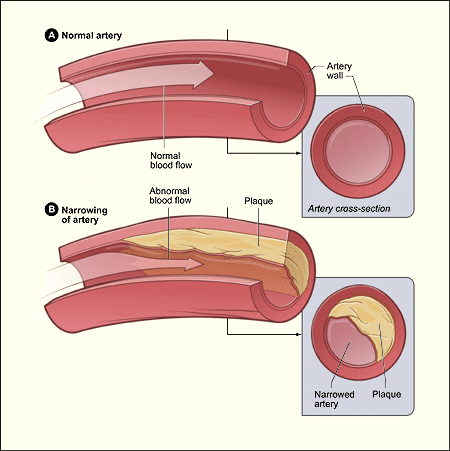What is cardiovascular disease?
Cardiovascular diseases (CVD) include coronary heart disease, stroke, hypertension, and rheumatic heart disease. The most common form is atherosclerotic diseases of the heart and vascular system. CVD is the most common cause of death in the United States. It kills more people than the next six leading causes of death combined.
CVD is the product of atherosclerosis, the progressive accretion of plaque (fatty deposits) on vessel walls. Blood flow is decreased in vessels as this narrowing gets worse.
If a blood clot lodges in a vessel narrowed by atherosclerosis, the blood flow can be stopped completely and the tissues downstream will die. When this takes place in a heart vessel, a heart attack transpires.

Why is cardiovascular disease so important?
The prevalence of CVD is not improving. The decline in deaths from CVD is not due to changes in lifestyle, such as diet, but because of improvements in medical care. And while heart attack deaths have declined substantially, hospital admissions for heart attacks have not.
CVD is a preventable disease in a majority of the population and should be treated as such. Alterations in diet, exercise, and lifestyle can prevent CVD from occurring and reverse its deleterious effects.
“Heart disease need never exist. If it does exist, it need never progress.”
–Dr. Caldwell B. Esselstyn Jr., former surgeon and researcher at the Cleveland Clinic“All males 65 years and older who have been exposed to the traditional Western diet have cardiovascular disease and should be treated as such.”
–Dr. Lewis Kuller
What you should know
There was a sharp decline in CVD during World War II; this is thought to be due to the scarcity of meat, butter, sugar and eggs — as well as calories in general. With gasoline strictly rationed, more people traveled by foot.
Plant-based diets have been successful at arresting CVD and even reversing it. This may be due to the high amounts of fibre and low amounts of saturated and trans fat. Or it could be due to the fact that plant-based diets are often lower in calories.
Incorporating soy products into the diet can lower bad cholesterol levels, homocysteine, and blood pressure. (See All About Soy.)
Consuming high amounts of fruits and vegetables can improve vessel elasticity. Even the regular consumption of whole grain foods has been shown to improve heart health.
Another important factor regarding dietary intake is the composition of dietary fat. Omega-3 fats are anti-inflammatory and prevent blood clotting. Omega-3 fats have been shown to increase survival rates after suffering a heart attack.
The role of inflammation in the development of CVD is becoming more apparent. As previously mentioned, the type of dietary fat one consumes can help to control inflammation.
Furthermore, losing body fat and partaking in regular exercise can also be anti-inflammatory. Physical inactivity is recognized as a major risk factor for CVD.
People who are inactive can improve their health by becoming just moderately active. Physical activity does not need to be strenuous to achieve health benefits. Expending just 1,000 calories per week via exercise can lead to health benefits.
In someone with established CVD, the exercise goals and outcomes may include relief of anginal symptoms (i.e. chest pain), increased maximal oxygen consumption, decreased body fat, decreased blood pressure, increased good cholesterol, and protection against another heart attack triggered by increased work intensities.
For extra credit
Sodium intake is independently associated with the risk of developing CVD although many experts believe that higher sodium intakes in the face of proper nutrition and exercise are not problematic.
Nearly 2,400 Americans die of CVD each day — an average of 1 death every 37 seconds.
Coronary heart disease caused 1 of every 5 deaths in the United States in 2004.
Each year, more than $33 billion in medical costs and $9 billion in lost productivity as a result of heart disease, cancer, stroke, and diabetes are attributed to poor nutrition.
Beta-blockers (used to treat/manage heart disease) decrease heart rate and exercise capacity (especially with non-selective agents)
“I don’t understand why asking people to eat a well-balanced vegetarian diet is considered drastic, while it is medically conservative to cut people open.”
— Dean Ornish, M.D.
Summary and recommendations
- Eat a fruit and or vegetable with every meal
- Eat legumes at least 5 times per week
- Eat only whole, unprocessed grains
- Avoid trans fat consumption
- Exercise for 5 hours per week; reach this goal gradually if you have existing CVD
- Decrease amounts of excess body fat
- Avoid refined carbohydrates
- No less than 25 grams of fibre per day
- Avoid processed foods
- Eat/supplement with foods containing omega-3 fats. Be aware of potential interactions with blood thinning medications.
Eat, move, and live… better.©
Yep, we know… the health and fitness world can sometimes be a confusing place. But it doesn’t have to be.
Let us help you make sense of it all with this free special report.
In it you’ll learn the best eating, exercise, and lifestyle strategies — unique and personal — for you.
Click here to download the special report, for free.
References
Click here to view the information sources referenced in this article.




Share